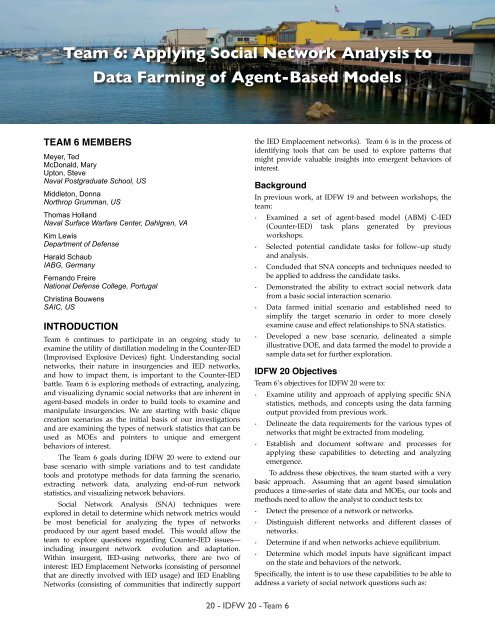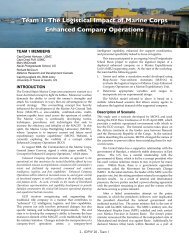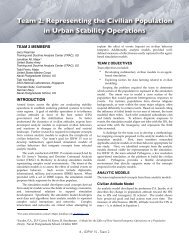pdf file - SEED Center for Data Farming - Naval Postgraduate School
pdf file - SEED Center for Data Farming - Naval Postgraduate School
pdf file - SEED Center for Data Farming - Naval Postgraduate School
Create successful ePaper yourself
Turn your PDF publications into a flip-book with our unique Google optimized e-Paper software.
Team 6: Applying Social Network Analysis to<br />
<strong>Data</strong> <strong>Farming</strong> of Agent-Based Models<br />
TEAM 6 MEMBERS<br />
Meyer, Ted<br />
McDonald, Mary<br />
Upton, Steve<br />
<strong>Naval</strong> <strong>Postgraduate</strong> <strong>School</strong>, US<br />
Middleton, Donna<br />
Northrop Grumman, US<br />
Thomas Holland<br />
<strong>Naval</strong> Surface Warfare <strong>Center</strong>, Dahlgren, VA<br />
Kim Lewis<br />
Department of Defense<br />
Harald Schaub<br />
IABG, Germany<br />
Fernando Freire<br />
National Defense College, Portugal<br />
Christina Bouwens<br />
SAIC, US<br />
INTRODUCTION<br />
Team 6 continues to participate in an ongoing study to<br />
examine the utility of distillation modeling in the Counter-IED<br />
(Improvised Explosive Devices) fight. Understanding social<br />
networks, their nature in insurgencies and IED networks,<br />
and how to impact them, is important to the Counter-IED<br />
battle. Team 6 is exploring methods of extracting, analyzing,<br />
and visualizing dynamic social networks that are inherent in<br />
agent-based models in order to build tools to examine and<br />
manipulate insurgencies. We are starting with basic clique<br />
creation scenarios as the initial basis of our investigations<br />
and are examining the types of network statistics that can be<br />
used as MOEs and pointers to unique and emergent<br />
behaviors of interest.<br />
The Team 6 goals during IDFW 20 were to extend our<br />
base scenario with simple variations and to test candidate<br />
tools and prototype methods <strong>for</strong> data farming the scenario,<br />
extracting network data, analyzing end-of-run network<br />
statistics, and visualizing network behaviors.<br />
Social Network Analysis (SNA) techniques were<br />
explored in detail to determine which network metrics would<br />
be most beneficial <strong>for</strong> analyzing the types of networks<br />
produced by our agent based model. This would allow the<br />
team to explore questions regarding Counter-IED issues—<br />
including insurgent network evolution and adaptation.<br />
Within insurgent, IED-using networks, there are two of<br />
interest: IED Emplacement Networks (consisting of personnel<br />
that are directly involved with IED usage) and IED Enabling<br />
Networks (consisting of communities that indirectly support<br />
the IED Emplacement networks). Team 6 is in the process of<br />
identifying tools that can be used to explore patterns that<br />
might provide valuable insights into emergent behaviors of<br />
interest.<br />
Background<br />
In previous work, at IDFW 19 and between workshops, the<br />
team:<br />
· Examined a set of agent-based model (ABM) C-IED<br />
(Counter-IED) task plans generated by previous<br />
workshops.<br />
· Selected potential candidate tasks <strong>for</strong> follow–up study<br />
and analysis.<br />
· Concluded that SNA concepts and techniques needed to<br />
be applied to address the candidate tasks.<br />
· Demonstrated the ability to extract social network data<br />
from a basic social interaction scenario.<br />
· <strong>Data</strong> farmed initial scenario and established need to<br />
simplify the target scenario in order to more closely<br />
examine cause and effect relationships to SNA statistics.<br />
· Developed a new base scenario, delineated a simple<br />
illustrative DOE, and data farmed the model to provide a<br />
sample data set <strong>for</strong> further exploration.<br />
IDFW 20 Objectives<br />
Team 6’s objectives <strong>for</strong> IDFW 20 were to:<br />
· Examine utility and approach of applying specific SNA<br />
statistics, methods, and concepts using the data farming<br />
output provided from previous work.<br />
· Delineate the data requirements <strong>for</strong> the various types of<br />
networks that might be extracted from modeling.<br />
· Establish and document software and processes <strong>for</strong><br />
applying these capabilities to detecting and analyzing<br />
emergence.<br />
To address these objectives, the team started with a very<br />
basic approach. Assuming that an agent based simulation<br />
produces a time-series of state data and MOEs, our tools and<br />
methods need to allow the analyst to conduct tests to:<br />
· Detect the presence of a network or networks.<br />
· Distinguish different networks and different classes of<br />
networks.<br />
· Determine if and when networks achieve equilibrium.<br />
· Determine which model inputs have significant impact<br />
on the state and behaviors of the network.<br />
Specifically, the intent is to use these capabilities to be able to<br />
address a variety of social network questions such as:<br />
20 - IDFW 20 - Team 6




